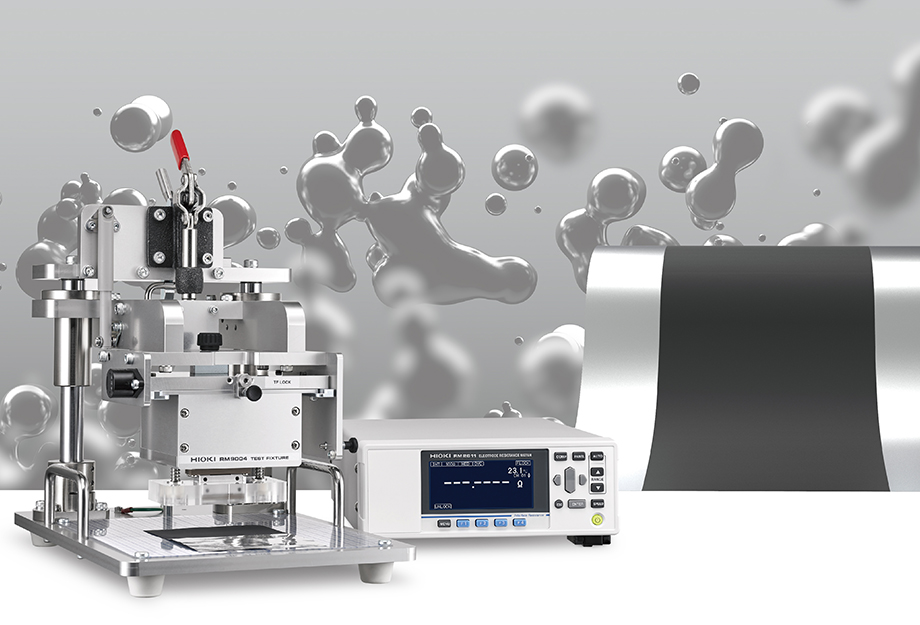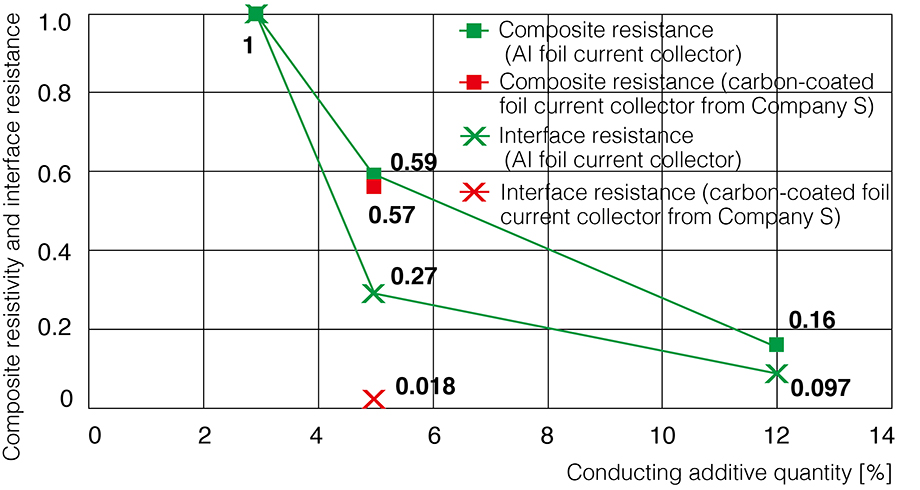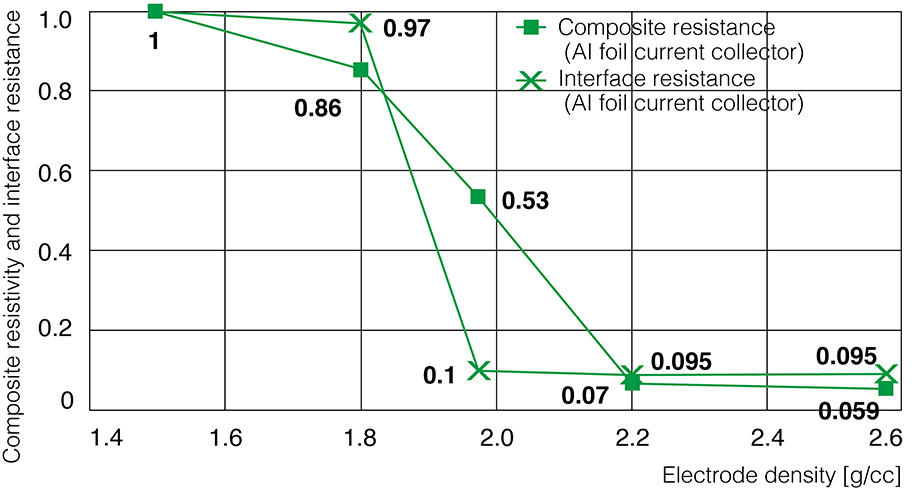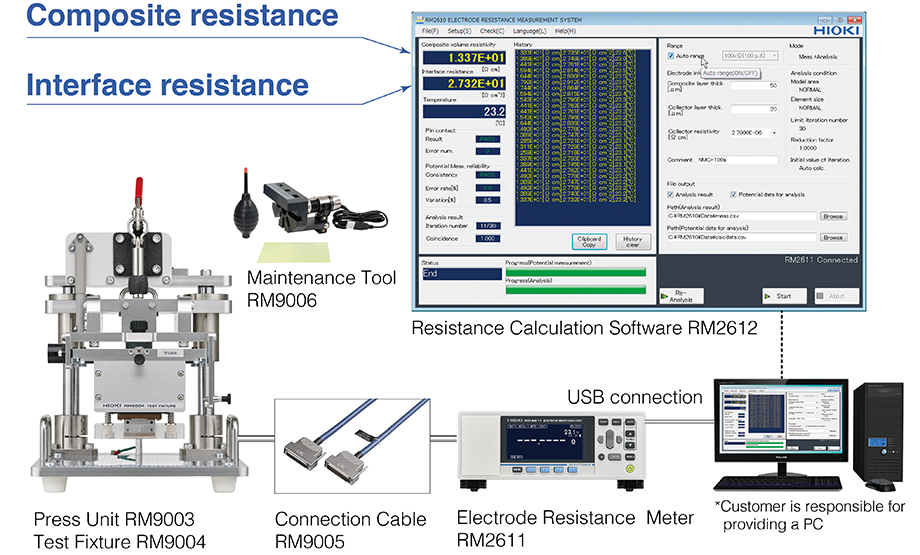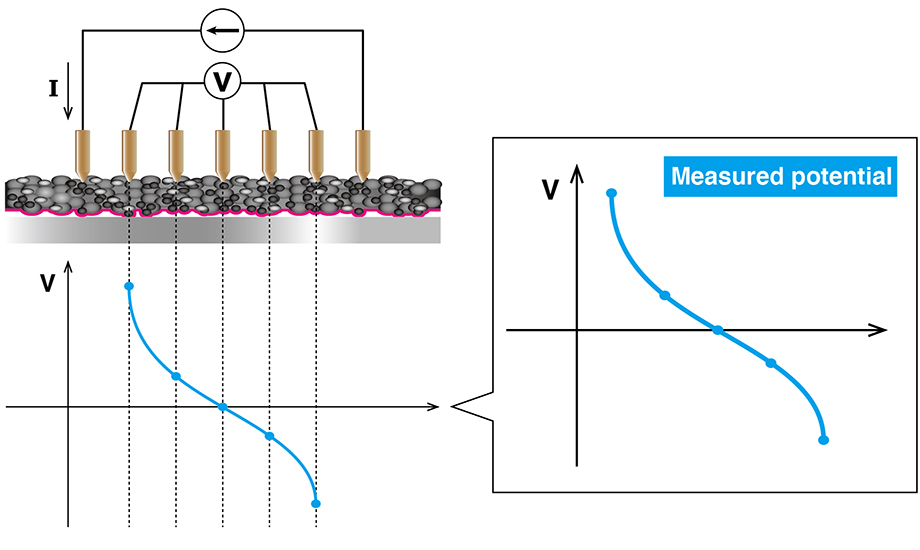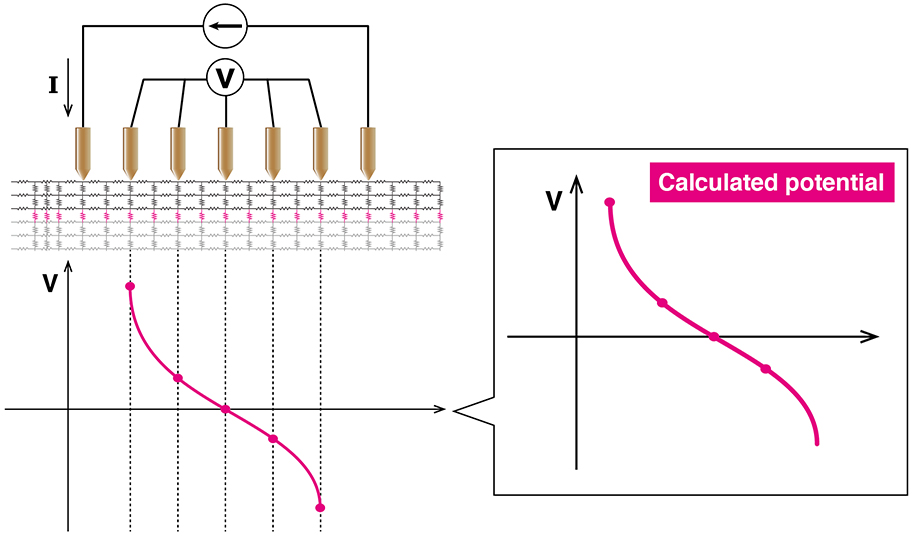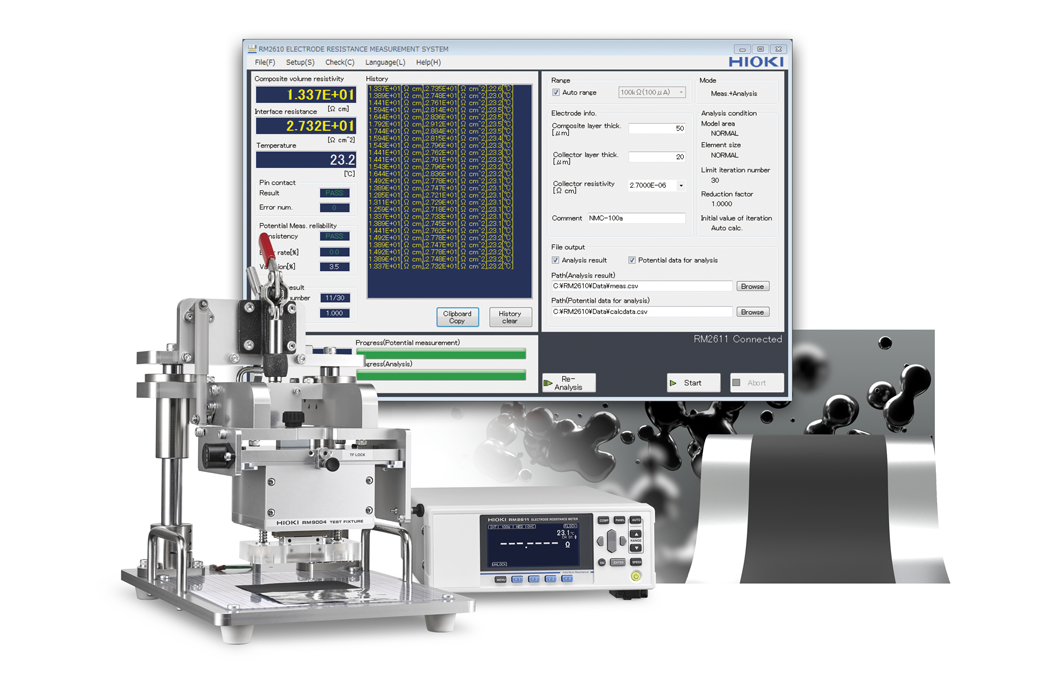Quantifying the Composite Layer Resistance and Interface Resistivity of Lithium-ion Battery Electrode Sheets
Helping shorten development times while facilitating quality control of mass-produced parts
Lightweight, high capacity lithium-ion batteries (LIBs) are widely used in smartphones and cordless devices worldwide. In recent years, LIBs have attracted attention as a power source for electric vehicles (EVs), and the industry is now accelerating improvement and development efforts to realize higher capacity and reduce weight in anticipation of their widespread use in that role.
The Electrode Resistance Measurement System RM2610 is the world’s first measurement and analysis system that can isolate and quantify the resistance of LIB positive and negative electrode sheets into composite layer resistance and the contact (interface) resistance between the composite layer and collector.
 Electrode sheet diagram
Electrode sheet diagram
1: Composite layer
2: Interface between composite and current collector
3: Current collector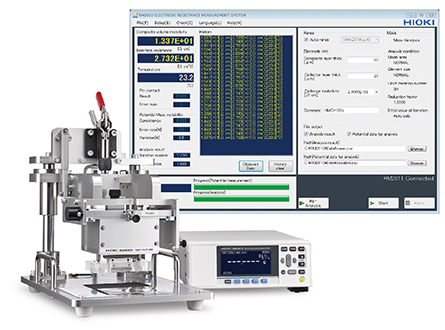 Electrode Resistance Measurement System RM2610
Electrode Resistance Measurement System RM2610Learn more about RM2610 here
Battery, EV, and material manufacturers who wish to ascertain resistance characteristics in a fine-grained manner during upstream processes
Issue 1: LIB development is time-consuming
Reducing internal resistance is key in the effort to improve LIB performance. It’s also necessary to ascertain the resistance characteristics of electrode sheets, a major material in batteries, in a fine-grained manner and to study the effects of those characteristics on materials, manufacturing methods, and other aspects of the production process. Being able to ascertain resistance characteristics in the electrode sheet state means being able to ascertain changes caused by differences in materials and the electrode sheet manufacturing process. However, to date there has been no technique for evaluating resistance characteristics in the electrode sheet state in a fine-grained manner. It’s typical to evaluate the characteristics of cells, but it takes time to prepare and evaluate cells using different combinations of materials and processes. Development times can be shortened by sorting parts mostly in the electrode sheet state and then evaluating cells using the sorted electrode sheets.
Issue 2: Mass-produced cells exhibit inconsistent quality
Mass-produced cells need to exhibit consistent quality. Quality control on upstream processes is critical in order to ensure consistent quality in the end. Managing quality in the electrode sheet state helps improve production efficiency.
Issue 3: Conventional methods don’t provide a fine-grained understanding of characteristics
Methods for measuring resistance characteristics in the electrode sheet state include 4-probe and pass-through resistance measurement. However, those methods measure the resistance characteristics of the entire electrode sheet. They cannot provide an understanding of composite layer resistance or interface resistance. It’s necessary to isolate and quantify composite layer resistance and interface resistance.
Issue 4: Materials manufacturers want to convey the advantages of their products to battery manufacturers
Manufacturers of slurry materials want to communicate the effects of their materials on cell characteristics in a specific manner. The evaluated data of the electrode sheet can provide more realistic effects on the slurry material than the evaluated data of a cell.
Benefits of visualizing the composite layer resistance and interface resistance in electrode sheets
The RM2610 is a measurement and analysis system that can isolate and quantify electrode sheets’ composite layer resistance and interface resistance, two properties that have been impossible to visualize until now. The system places a test fixture (consisting of multiple test probes) in contact with the surface of the electrode sheet to measure potential and then uses a proprietary Hioki analytical method to quantify composite layer resistance and interface resistance. Those values can be used to ascertain changes in electrode sheet characteristics caused by differences in materials, composition, and manufacturing conditions. Assuring quality during the electrode sheet fabrication process promises to speed development work driving LIB evolution and improvements while improving production yields.
Accelerates development by understanding the composite layer resistance and interface resistance: Battery and material manufacturer
By ascertaining changes in composite layer resistance and interface resistance while varying the conductive auxiliary agent, manufacturers have been able to identify appropriate conductive auxiliary agents that lower interface resistance. They’ve also been able to review changes in interface resistance caused by the presence or absence of a carbon coating. In this way, battery manufacturers have been able to accelerate development. Material manufacturers have gained the ability to communicate the advantages of their materials to battery manufacturers.
Became a factor in determining the optimal value of press force: Battery manufacturers
By quantifying the results of changes in electrode density realized by varying press force, manufacturers have gained an understanding of how electrode density affects interface resistance. They’ve learned that although higher press force settings and greater electrode densities reduce both the composite layer’s volume resistivity and interface resistance, the latter declines abruptly to a certain point and then remains roughly uniform, providing useful information for determining optimal press force values.
Overview of the Electrode Resistance Measurement System
The RM2610 consists of the Electrode Resistance Meter RM2611, Electrode Resistance Calculation Software RM2612, Press Unit RM9003, Test Fixture RM9004, Connection Cable RM9005, and Maintenance Tool RM9006. Calculations use a technique known as fitting to isolate and quantify the composite layer resistance and interface resistance.
First, the Test Fixture RM9004, which consists of multiple probes, is placed in contact with the surface of the electrode sheet, and current is applied between two specific probes.
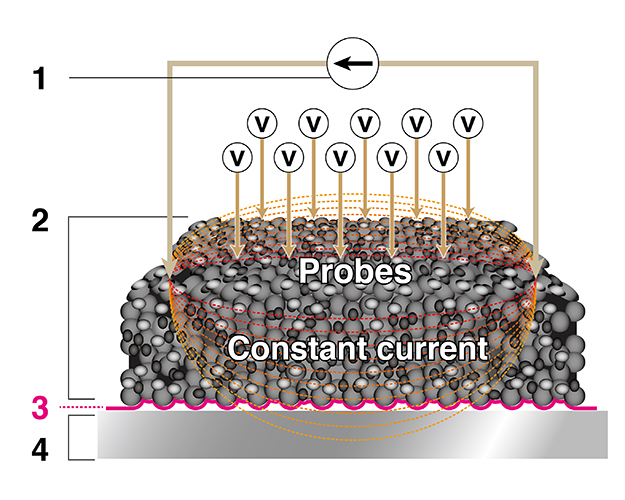 1: Constant current source
1: Constant current source
2: Composite layer
3: Interface between composite and current collector
4: Current collector
The applied current is distributed in a three-dimensional manner within the electrode sheet, creating a potential distribution on the surface of the sheet. Voltage measurement probes are used to measure that potential distribution. The potential obtained here is known as the measured potential.
Hioki came up with an electrode sheet model for calculating the potential values on its surface. The potential values obtained using this model serve as the calculated potential.
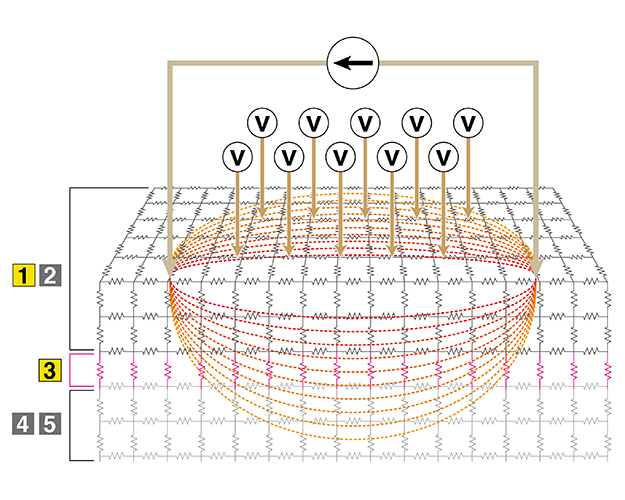 1: composite resistance
1: composite resistance
2: composite thickness
3: interface resistance
4: collector resistance
5: collector thickness
Calculated potential figures are repeatedly calculated while varying the composite layer resistance and interface resistance as variables. The values for which the measured potential and calculated potential values most closely approach one another in the course of these repeated calculations are output as the composite layer resistance and interface resistance.
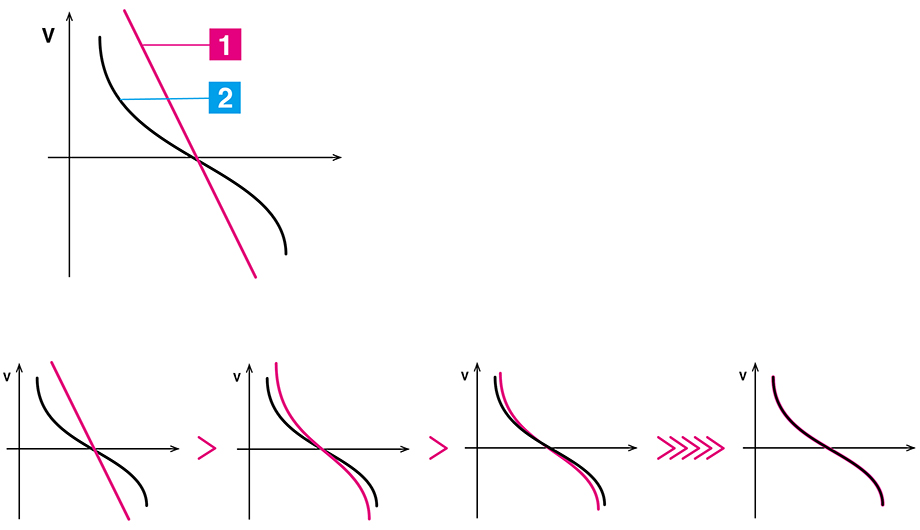 1.Calculated potential, 2.Measured potential
1.Calculated potential, 2.Measured potential
Computations are repeated until the measured potential and the calculated potential agreeLearn more about RM2610 here
Hioki solutions to accommodate the evolution of LIBs
LIBs will continue to evolve going forward. Manufacturers will continue to vary battery materials, additives, composition, material proportions, and process conditions in a quest to realize higher performance. Hioki developed the RM2610, a system for isolating and quantifying electrode sheets’ composite layer resistance and interface resistance, as a solution for use in the upstream processes of LIB manufacturing. We’ve also proposed a new method for analyzing electrode slurries in upstream processes. Proprietary Hioki analytical technology is used to analyze impedance measured values of LIB electrode slurries to derive the dispersibility of conductive materials and the degree of development of conductive networks.
Learn more about Slurry Analytical System hereAs adoption of EVs and the Internet of Things (IoT) grows, so too will demand for LIBs, leading to a shorter development cycle and more stringent safety and cost requirements. Hioki offers a broad range of measuring instruments with functionality engineered to meet customers’ demands for use in LIB R&D and manufacturing processes. Demonstration instruments are available, so please contact Hioki if you wish to experience the functionality of our products for yourself. We’re also happy to provide samples so that prospective customers can conduct measurement tests. And please get in touch with any measurement issues you’d like to resolve or instruments in which you're interested.
Learn more

